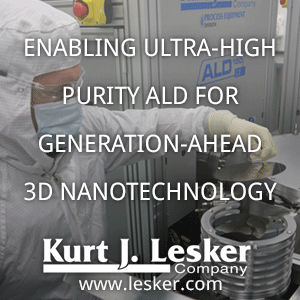Saturday, February 27, 2021
2021 ISSCC - Plenary Session with Dr. Mark Liu, TSMC Chairman
Friday, February 26, 2021
ASM International N.V. reports its 4Q/2020 operating results and the fourth consecutive year of double-digit growth
ASM International the leading supplier of single wafer ALD wafer processing equipment in the semiconductor industry reports that 2020 was the fourth consecutive year of double-digit growth.
- 4Q/2020 was driven by the logic/foundry segment, solid growth in China and a strong increase in spares & service business.
- ASM expects the single wafer ALD market to reach a size of approx. US$1.5 billion by ‘20-’21, and to grow substantially above that level in subsequent later years.
- Next ASM focus is on expanding their addressable market within the single wafer ALD space.
Source: 4Q/2020 Earings press release and investor presentation (LINK)
Area-selective MLD of nylon 6: Growth on carbon and inhibition on silica for a-carbon hardmask repair
Area-selective molecular layer deposition of nylon 6,2 polyamide: Growth on carbon and inhibition on silica
Journal of Vacuum Science & Technology A 39, 023204 (2021); https://doi.org/10.1116/6.0000769Marcel Junige and Steven M. George
Tech Insights Teardown: Samsung’s D1z DRAM with EUV Lithography
Reuters: SK Hynix signs five-year deal worth $4.3 billion with ASML to secure EUV scanners
Wednesday, February 24, 2021
The Nanotechnology Show October 13 - 14, 2021 Edison, New Jersey, USA
The Nanotechnology Show October 13 - 14, 2021 Edison, New Jersey, USA
Tuesday, February 23, 2021
Progress and future prospects of negative capacitance electronics: A materials perspective
1. Robust ferroelectricity at 5 nm thickness and below
2. Compatibility with CMOS technology
3. Thermal stability on silicon
4. Conformal deposition on 3D substrates
5. Large electronic bandgap and conduction band offset to Si
Progress and future prospects of negative capacitance electronics: A materials perspective
Thermal Atomic Layer Deposition of Gold: Mechanistic Insights, Nucleation, and Epitaxy
Thermal Atomic Layer Deposition of Gold: Mechanistic Insights, Nucleation, and Epitaxy
Pengfei Liu, Yuchen Zhang, Cong Liu, Jonathan D. Emery, Anusheela Das, Michael J. Bedzyk,Adam S. Hock*, and Alex B. F. Martinson*
ACS Appl. Mater. Interfaces 2021, XXXX, XXX, XXX-XXX
Thursday, February 18, 2021
Ferroelectric Field Effect Transistors (FeFETs) Bring Promise And Challenges
CEO interview: FMC’s Pourkeramati on roadmaps, turning away investors
https://www.eenewsanalog.com/news/ceo-interview-fmcs-pourkeramati-roadmaps-turning-away-investors
Friday, February 12, 2021
SIA Webinar: A Review of the 2020 Semiconductor Market and a Look to 2021
Safer medical devices with Picosun’s antimicrobial ALD coatings
“The aseptic properties of our ALD films are so excellent that they surpass even the strictest requirements of the medical implant industry."
Thursday, February 11, 2021
Imec Demonstrates 20nm Pitch Line/Space Resist Imaging with High-NA EUV Interference Lithography
Source: LINK
----------------------------
By Abhishekkumar Thakur
Tuesday, February 9, 2021
Capacitorless DRAM using oxide semiconductors could be built in 3D layers above a processor’s silicon
Saturday, February 6, 2021
Quantumcat, the ALD-coated sticker that fights against surface contamination and COVID19
A self-disinfecting virucidal sticker
Protection at the service of touch screens
Wednesday, February 3, 2021
Call for Abstracts - The 5th AVS Area Selective Deposition Workshop (ASD 2021)
LIVE Stream - Advanced Process Technologies to Enable Future Devices and Scaling (invited), Rob Clark Tokyo Electron
Sunday, January 31, 2021
AVS Webinar: Plasma-Assisted Atomic Layer Deposition: From Basics to Applications
- Provide the basic concepts of plasma-based processing and thin-film preparation by (plasma-assisted) ALD
- Gain knowledge on the role of reactive and energetic species such as radicals, ions, and photons on the process and resulting film properties, including film conformality on 3D surface topologies
- Present an overview of plasma ALD reactors and discuss important design and processes parameters
- Discuss several plasma-assisted ALD processes for key material systems
- Give insight into existing and potential future applications of plasma-assisted ALD
- Understand the pros and cons of plasma-assisted ALD with respect to thermal ALD
Friday, January 29, 2021
Live Web-Event „SIMULATION FOR ALD″ on March 25, 2021
- Live Web-Event „SIMULATION FOR ALD″ on March 25, 2021
- Live Presentations, Simulation Talk, After Work Discussion, Online Market Place
Thursday, January 28, 2021
Micron Delivers Industry’s First 1α DRAM Technology
Wednesday, January 27, 2021
Call for Abstracts ALD & ALE 2021 Tampa,FL, USA
|



%20(1).png)























